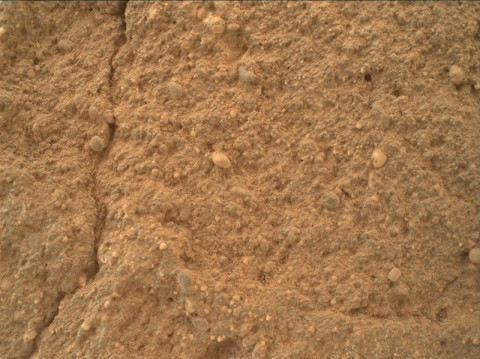Written by Guy Webster
NASA’s Jet Propulsion Laboratory
 Pasadena, CA – NASA’s Curiosity Mars rover is examining a valley where at least two types of bedrock meet, for clues about changes in ancient environmental conditions recorded by the rock.
Pasadena, CA – NASA’s Curiosity Mars rover is examining a valley where at least two types of bedrock meet, for clues about changes in ancient environmental conditions recorded by the rock.
In addition to two rock types for which this site was chosen, the rover has found a sandstone with grains of differing shapes and color.
Curiosity’s international team has resumed full operations of the car-size mobile laboratory after a period of limited activity during most of June.

At the rover’s current location near “Marias Pass” on Mount Sharp, Curiosity has found a zone where different types of bedrock neighbor each other.
One is pale mudstone, like bedrock the mission examined previously at “Pahump Hills.”
Another is darker, finely bedded sandstone above the Pahrump-like mudstone. The rover team calls this sandstone the Stimson unit.

On Mars as on Earth, each layer of a sedimentary rock tells a story about the environment in which it was formed and modified. Contacts between adjacent layers hold particular interest as sites where changes in environmental conditions may be studied. Some contacts show smooth transitions; others are abrupt.
› Rover team members have resumed commanding Curiosity after a moratorium while the sun was between Earth and Mars.
› Curiosity is examining a zone where two regional rock units neighbor each other near “Marias Pass.”
› The rover found a sandstone with grains of diverse size, shape and color.
Curiosity climbed an incline of up to 21 degrees in late May to reach Marias Pass, guided by images from NASA’s Mars Reconnaissance Orbiter showing Pahrump-like and Stimson outcrops close together.
“This site has exactly what we were looking for, and perhaps something extra,” said Curiosity Project Scientist Ashwin Vasavada, of NASA’s Jet Propulsion Laboratory, Pasadena, California. “Right at the contact between the Pahrump-like mudstone and the Stimson sandstone, there appears to be a thin band of coarser-grained rock that’s different from either of them.”
The in-between material is a sandstone that includes some larger grains, of mixed shapes and colors, compared to the overlying dark sandstone.
“The roundedness of some of the grains suggests they traveled long distances, but others are angular, perhaps meaning that they came from close by,” Vasavada said. “Some grains are dark, others much lighter, which indicates that their composition varies. The grains are more diverse than in other sandstone we’ve examined with Curiosity.”
Curiosity has been exploring on Mars since 2012. It reached the base of Mount Sharp last year after fruitfully investigating outcrops closer to its landing site and then trekking to the mountain. The main mission objective now is to examine successively higher layers of Mount Sharp.
JPL, a division of the California Institute of Technology in Pasadena, built the rover and manages the project for NASA’s Science Mission Directorate in Washington. For more information about Curiosity, visit:
http://www.nasa.gov/msl
http://mars.jpl.nasa.gov/msl/
You can follow the mission on Facebook and Twitter at:
http://www.facebook.com/marscuriosity


